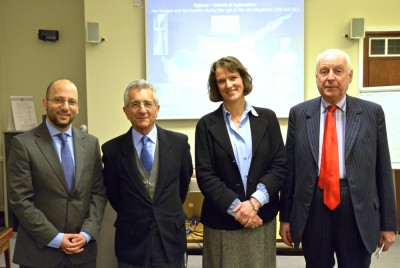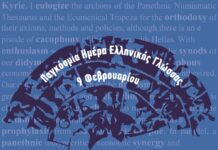Διάλεξη σε αίθουσα του University of London με θέμα «Κύπρος, Νησί της Αφροδίτης: Οι εικόνες της, η λατρεία και τα ιερά της κατά την περίοδο των πόλεων-βασιλείων (Αρχαϊκή και Κλασική περίοδοι) παραχώρησε η Δρ Άνια Ούλμπριχ, Έφορος Α.Γ. Λεβέντη της κυπριακής συλλογής στο Μουσείο Ashmolean της Οξφόρδης.
Η διάλεξη ξεκίνησε με παραπομπές σε αναφορές στην Αφροδίτη που εντοπίζονται στα αρχαιοελληνικά κείμενα, κυρίως στον Όμηρο και στον Ησίοδο, στις οποίες προσφωνείται «πότνια Κύπρου» και περιγράφεται ως η πιο σημαντική θεότητα στο νησί κατά την περίοδο των πόλεων-βασιλείων (περίπου 750-310 π.Χ.).
Το πρώτο μέρος της διάλεξης επικεντρώθηκε στις απεικονίσεις των αναθηματικών μορφών σε πέτρα και κεραμικά από τα ιερά της, ιδίως σε όσα αναφέρεται ως Κυπρία Αφροδίτη. Σημειώθηκε ότι στις αφιερωματικές επιγραφές στην Κύπρο δεν αποκαλείτο Αφροδίτη, παρά μόνο από την εποχή του Μεγάλου Αλεξάνδρου και μετά. Το δεύτερο σκέλος της παρουσίασης της Δρ. Ούλμπριχ ασχολήθηκε με την κατανομή και την τοπογραφία των τόπων λατρείας της στην Κύπρο και στα αστικά κέντρα και εδάφη των 12 αυτόνομων πόλεων-βασιλείων του νησιού.
Μέσα από την ανάλυσή της η εισηγήτρια κατέληξε στο πειστικό συμπέρασμα πως τόσο οι αναπαραστάσεις των αναθηματικών μορφών όσο και η τοπογραφία των ιερών της επιβεβαιώνει με τρόπο ξεκάθαρο τον «τόπο» στην ελληνική λογοτεχνία ότι η Κύπρος ήταν πραγματικά το νησί της Αφροδίτης.
Η διάλεξη διοργανώθηκε από τους Φίλους της Βρετανικής Σχολής Αθηνών. Συντονιστής ήταν ο αρχαιολόγος Τζέραλντ Κάντογκαν, ενώ παρέστη πλήθος Βρετανών αρχαιολόγων, κλασικιστών και ενδιαφερομένων. Παρόντες επίσης ήταν οι Κύπριοι Α. Π. Λεβέντης, διευθυντής του Ιδρύματος Α.Γ. Λεβέντης, Αχιλλέας Χατζηκυριάκου, Μορφωτικός Σύμβουλος της Υπάτης Αρμοστείας της Κυπριακής Δημοκρατίας στο Η.Β. και Δώρος Παρτασίδης, γνωστός φωτογράφος και κινηματογραφιστής του ΡΙΚ.
Αναφερόμενος στη διάλεξη, η οποία ακολουθήθηκε από πληθώρα ερωτημάτων από το ακροατήριο, ο κ. Χατζηκυριάκου υπογράμμισε το γεγονός ότι η έρευνα της Δρ. Ούλμπριχ επέτρεψε στο ακροατήριο να εκτιμήσει τις σύνθετες κοινωνικές, πολιτιστικές, θρησκευτικές και ιστορικές συνεκδοχές της «Μεγάλης Θεάς της Κύπρου».
Όπως είπε: «Η Κύπρος είναι ευρέως γνωστή ως το Νησί της Αφροδίτης, αλλά υπάρχουν ακόμα πολλά να μάθουμε από τη συνεχιζόμενη αρχαιολογική έρευνα σχετικά με τη σημασία της Θεάς, σε ένα σταυροδρόμι αρχαίων πολιτισμών και ιστοριών. Η Δρ Ούλμπριχ, κορυφαία ακαδημαϊκός στον τομέα αυτό, παρείχε πρωτότυπες λεπτομέρειες της παρουσίας της Αφροδίτης στο νησί κατά την Αρχαϊκή και Κλασική περίοδο, ενώ ταυτόχρονα εξερεύνησε με τρόπο πειστικό την αλλαγή στις φυσικές αναπαραστάσεις και τους θρησκευτικούς συμβολισμούς της Θεάς στο πέρασμα του χρόνου και σε πολλούς τόπους».
Cyprus, Island of Aphrodite: Her images, cult and sanctuaries during the era of the city kingdoms
(Archaic and Classical Periods)
Dr Anja Ulbrich, A.G. Leventis curator of Cypriot Antiquities in the Ashmolean Museum, Oxford, recently delivered a lecture on Cyprus, Island of Aphrodite: Her images, cult and sanctuaries during the era of the city kingdoms (Archaic and Classical Periods) at Senate House, University of London.

The lecture was organised by the Friends of the British School at Athens, chaired by the archaeologist Gerald Cadogan, and attended by Mr A. P. Leventis, the director of the A.G. Leventis Foundation, Dr Achilleas Hadjikyriacou, the cultural counsellor of the Cyprus High Commission, Doros Partassides, representative of Cyprus Television, and a mixed audience of archaeologists, classicists and the public.
The starting point of the intriguing, richly illustrated lecture was Greek literature, mostly Homer and Hesiod, which vaguely portrays Aphrodite, frequently called “Kypris” or “Lady of Cyprus” (potnia Kyprou in Greek), as the most important deity on the island with universal powers, facets and functions in the Cypriot society and religion during the age of the city-kingdoms (ca. 750-310 BC).
Dr Ulbrich went on to explore the significance and various functions of the goddess by analysing the archaeological evidence from and for her sanctuaries in Cyprus proper. The first part of the lecture focused on the imagery of the votive figures in stone and terracotta from her sanctuaries, particularly those portraying her or referring to Cypriot Aphrodite, not called Aphrodite in Cypriot dedicatory inscriptions before the time of Alexander the Great. A second part investigated the distribution and topography of her cult-sites in Cyprus and in the urban centres and territories of the island’s 12 autonomous city-kingdoms.
Through the period under review, various different types of images of or referring to Cypriot Aphrodite were dedicated as votive figures to the goddess. They reflect both, her various aspects and functions as well as the multi-cultural nature of Cypriot society at the time. Thus,
the image-types of a naked female, sometimes supporting her breasts or of a pregnant enthroned woman or goddess, characterized Kypris as goddess of sex, love and fertility. They were introduced from Phoenicia in the 7th or 5th century BC respectively, probably through Phoenicians in the Phoenician city-kingdom of Kition in Cyprus. Equally Phoenician inspired are the locally created capitals in the shape of the head of the Egyptian goddess Hathor functioning as images of Cypriot Aphrodite protecting the Cypriot kings and dynasties like Hathor did for the pharaohs in Egypt. Locally developed Cypriot image types, like of a such as “the goddess with a vegetal crown” visualized Cypriot Aphrodite as a goddess of vegetal fertility and agriculture and or a mural crown as city-goddess. While the addition of a deer placed her as goddess of wild animals and hunting close to Greek Artemis, a winged Eros on her arm showed her as Greek Aphrodite, goddess of erotic love.
A survey of the distribution of sanctuaries of the goddess in Cyprus, illustrated with various maps, showed that she was the dominant deity within the urban centres of all city-kingdoms as well as in towns in the territories. There she was worshipped in several sanctuaries at geographically prominent sites, such as on top of an acropolis, in a palace or near the city-gates, either in all her various aspects mentioned above, or different aspects of her were dominant at different urban cult places. The further away her sanctuaries lay from a city or larger town, the more her aspect of female and vegetal fertility and as a hunting goddess became prominent in the images of her votive-figurines. With increasing distance of from the urban centres and in the territory, more sanctuaries dedicated to a divine couple, including Cypriot Aphrodite, or to a male deity alone could be found. There, the male counterpart of the goddess had the qualities of a weather-god, a pastoral, and male fertility deity as well as of a war god.
The speaker convincingly concluded that both the imagery of the votive figures associated with Cypriot Aphrodite as well as the distribution and topography of her sanctuaries clearly confirmed the topos in Greek literature that Cyprus was truly the island of Aphrodite.
The lecture was very well received with several questions came coming from the audience and was followed by a reception during which lively discussions were continued.
Commenting on the lecture, Dr Achilleas Hadjikyriacou, the Cultural Counsellor of the Cyprus High Commission, highlighted the fact that Dr Ulbrich’s research allowed the audience to appreciate the complex social, cultural, religious and historical connotations of the “Great Goddess of Cyprus”. As he stated: “Cyprus is widely known as the Island of Aphrodite, but there is still a lot to learn from the ongoing archaeological research regarding the importance of the Goddess as at a cross point of ancient civilisations, cultures and histories. Dr Ulbrich, a leading scholar in this field, has provided original insights into the presence of Aphrodite in the Iisland during the Archaic and Classical periods while at the same time she convincingly explored exploring the change in the Goddess’ physical representations and religious symbolisms across time and place.”
Andreas Tambourides








